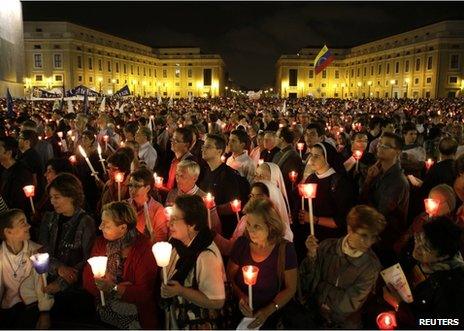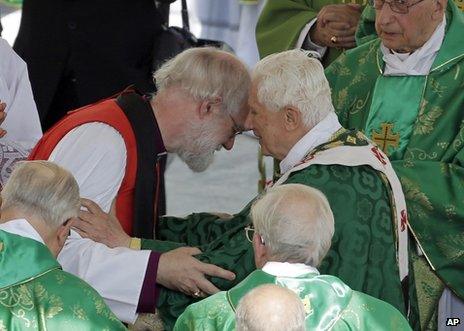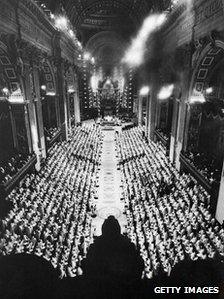Vatican II: Pope Benedict's unfinished business
- Published

A candlelight procession marked the anniversary at the Vatican
This week the Vatican celebrates the 50th anniversary of the Second Vatican Council (often known as Vatican II), called by Pope John XXIII in 1959 to reform and breathe new life into the Catholic Church as it prepared for the beginning of the third Christian millennium. Pope John said the idea had come to him "like a flash of heavenly light".
The world's 2,800 Catholic bishops gathered in Rome four times in the autumn of four consecutive years starting 11 October 1962, and engaged in seemingly robust debate.
But a close reading of the historical record of what actually happened reveals that the Council's lofty goals were never achieved. Pope John died the year after the first session. When his successor Pope Paul VI took over the running of the Council, John's initial vision and impetus had weakened.
The Roman Curia, the small body of cardinals and bishops that control Church policy under the guidance of the Pope, had had plenty of time to prepare for the meeting. The announcement of the summoning of the 21st Council in the 2,000-year history of the Church had initially taken them by surprise.
Between January 1959, when Pope John first announced the summoning of the Council, and October 1962, when it held its first session inside the sumptuous setting of St Peter's Basilica, the Curia drafted a series of preparatory texts which they intended the bishops to rubber-stamp.
But the bishops quickly found their own voice once they had arrived in Rome. They made it clear that they were there to lead, to engage in a genuine renewal of Church policies, not to follow blindly the instructions of the conservative Curia. Bishops from 116 countries, more than the then UN membership, gathered for the opening.
'Behind the times'
Ladislas Orsy, a 91-year-old Jesuit canon lawyer, who was an expert adviser at the Council, remembers how quickly the bishops learned how to exercise their collective power.

Archbishop of Canterbury Rowan Williams (left) met Pope Benedict at the Vatican to mark the anniversary
"They were educated in a system that knew nothing of collegiality and were trained to be obedient to the Pope but in a very, very short time - perhaps two or three weeks - with daring, but gently, they threw out the preparatory materials," he told Robert Mickens of The Tablet.
Some broad but significant changes effected by the Council concerned language - henceforth the Mass would be said in the vernacular instead of in Latin; and ritual - henceforth the priest would face his congregation instead of turning his back upon them. Relations with other religions became more cordial - in particular with Muslims and Jews.
Pope Benedict XVI, speaking at an anniversary mass in St Peter's Square, attended by a tiny group of surviving clerics like himself who actually took part in the work of the Council, deplored what he called a "desertification" of spiritual life during the years that have elapsed since the end of the Council in 1965.
"At that time," the Pope said, "it was already possible from a few tragic pages of history to know what life without God would be like."
"Now," he added, "we see it all around us."
Since his election as Pope seven years ago, Benedict has consistently tried to correct what he regards as a misinterpretation of Vatican II, insisting that it did not mark a revolutionary break from the past, as liberal Catholics would have it, but rather a renewal of the best traditions of the ancient Church.
He has launched a Year of Faith, beginning this month, seeking to bring back to the Church baptised Catholics who have fallen away from the fold during recent decades.
Benedict's critics accuse him of not keeping up with the times.
Hans Kueng, a distinguished Catholic theologian and former close friend of the Pope, has accused Benedict and his peers of spiritually still living in the Middle Ages, while Cardinal Carlo Maria Martini, an Italian biblical scholar who died recently, wrote on his deathbed that the Catholic Church still needed radical reform and was "200 years behind the times".
Toothless body
Pope Benedict argues that the Council represents continuity, not a radical revision of Church teaching for modern times.
In his desire to bring dissident Catholics back into the mainstream Church, Pope Benedict has been negotiating with a traditionalist Catholic Group based in Switzerland, known as the Society of Saint Pius X, which roundly rejects the reforms of Vatican II.

This image shows the bishops inside St Peter's Basilica in 1963
Two years ago he rehabilitated some of the Society's bishops who had been excommunicated by his predecessor, Pope John Paul II.
But talks have subsequently stalemated - although Benedict has conceded to Catholics nostalgic for the Latin Mass abandoned in most parts of the world after Vatican II, the possibility of returning to the old Latin missal.
The debate over the interpretation of the texts approved by the Council Fathers seems destined to continue.
Yet the prospect of the calling of a third Vatican Council (the first was held in 1870) has been dismissed by the Pope as inopportune.
The Synod of Bishops - a regular meeting of representatives from Episcopal conferences around the world - invented by Pope Paul VI as a sign that the Vatican Curia would continue to listen rather than to rule - has disappointed many of its participants over the years.
The current synod being held in Rome this month to discuss The New Evangelisation has no real collegial powers.
It is an advisory body with no teeth, and its agenda and final declaration are closely controlled by the Roman Curia, despite the cosmetic presence for the first time of an African-American woman Methodist bishop as one of the carefully selected foreign observers.
Change in the Catholic world since the 1960s has been huge. The Church's hub has shifted south. The average age of priests and nuns continues to grow alarmingly as the number of new vocations has shrivelled in formerly strongly Catholic countries of Europe.
The world's Catholic population during that decade was estimated at between 700 million and 800 million and today exceeds 1.3bn with the major increase recorded in Africa and Latin America, according to Vatican statistics.
And the world's Catholic bishops have almost doubled in number from 2,800 to over 5,000. It is doubtful whether they would even all fit into Saint Peter's Basilica if business left unfinished in 1965 were ever to be resumed.
- Published2 May 2013
- Published6 October 2012